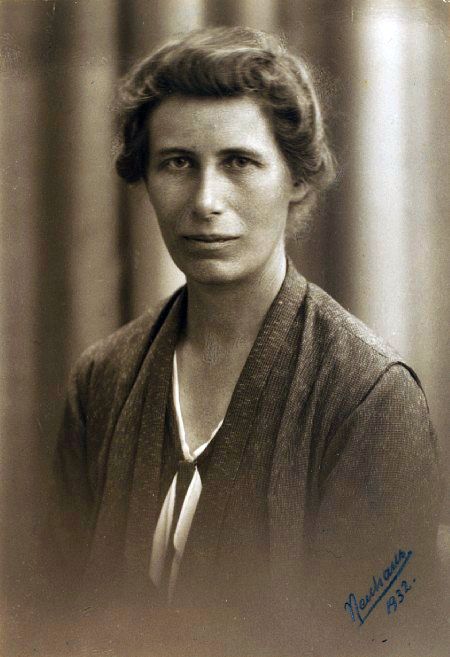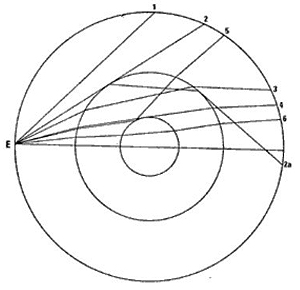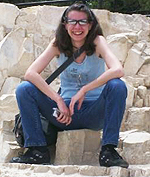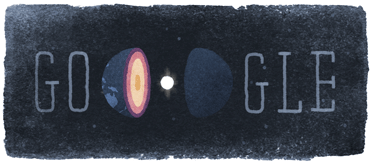By Dana Hunter
Rosetta Stones/Scientific American
Editor’s Note: Today would have been the 127th birthday of groundbreaking, Danish seismologist Inge Lehmann — a fact known by significantly more people today than yesterday, thanks to a nifty Google doodle in her honor:
In keeping with the occasion, we present a wonderful profile by science writer and new EarthDesk contributor, Dana Hunter, who calls herself a “compleat geology addict.” This post appeared in Dana’s Scientific American blog Rosetta Stones on March 8. More about Dana at the conclusion. ~ JC
At the age of 105, Inge Lehmann (1888-1993) looked back on a long, productive life with satisfaction. During her career in seismology, she had made two major discoveries, won multiple prestigious awards, become a fellow of the Royal Society, and had honorary doctorates bestowed by Columbia University and the University of Copenhagan. She was an immensely talented seismologist.

Inge Lehmann, 1932. [Public domain], via Wikimedia Commons
I may have been 15 or 16 years old when, on a Sunday morning, I was sitting at home together with my mother and sister, and the floor began to move under us. The hanging lamp swayed. It was very strange. My father came into the room. “It was an earthquake,'” he said. The center had evidently been at a considerable distance, for the movements felt slow and not shaky. In spite of a great deal of effort, an accurate epicenter was never found. This was my only experience with an earthquake until I became a seismologist 20 years later.
Inge was educated at a progressive high school where girls and boys were treated equally, unusual for the era:
No difference between the intellect of boys and girls was recognized, a fact that brought some disappointment later in life when I had to recognize that this was not the general attitude.
That equality might have had something to do with the fact that Niels Bohr’s aunt, Hannah Adler, ran the place.
School work didn’t excite Inge at all, but one of her mathematics teachers challenged her with special problems. She stayed with mathematics while studying at the University of Copenhagen, and added physics, chemistry, and astronomy to her studies. She was a driven and determined student, so much so that she pushed herself too hard while at Cambridge and had to take some time off before returning to her studies. She spent that time working in insurance.
Cambridge would not award university degrees to women until 1948. Inge returned to the University of Copenhagen, graduating in 1920. In 1925, she began working as an assistant to geodesist Niels Erik Nørlund, and her interest in seismology was rekindled:
I heard for the first time that knowledge of the earth’s interior composition could be obtained from the observations of seismographs. I was strongly interested in this and started reading about it.
She would practically teach herself seismology during those years while she and three young men installed seismological observatories in Denmark and Greenland. Some of the leading seismologists of the day would later assist her with her studies, and she graduated with a master’s degree in geodesy from the University of Copenhagen in 1928.

An earth model with constant velocity in each layer, 10 mm/s in the mantle, 8 km/s in the outer core and 8.6 km/s in the inner core. Figure and caption by Inge Lehmann.
Only a year later, an earthquake in New Zealand would lead her to her greatest discovery.
The behavior of certain seismic waves, called P’ (P-Prime) waves, didn’t match what would be expected “if the earth simply consisted of a hard mantle surrounding a fluid or soft core.” Inge considered different models, and discovered an interesting result:
The existence of a small solid core in the innermost part of the earth was seen to result in waves emerging at distances where it had not been possible to predict their presence.
She had glimpsed the interior of the earth. Prestigious seismologists like Charles Richter and Beno Gutenberg accepted her results quickly. She had cemented her position as one of the greatest living seismologists, but she would make a second important discovery – one that bears her name.
Inge Lehmann won respect for her discoveries, but she wasn’t immune to the rampant sexism in the sciences. “You should know how many incompetent men I had to compete with – in vain,” she told her nephew Niles Groes. She sacrificed marriage and family for her career, since women at that time could almost never have both. Her immense hard work, dedication to her field, and determination paid off in a brilliant career and discoveries that will ensure she’s remembered as the woman who discovered the true character of the center of the earth.
«« »»
 Dana Hunter is a science blogger, science fiction writer, and geology addict who lives in the midst of some of the most spectacular (and dangerous) geology in the world. Her Scientific American blog, Rosetta Stones, covers a wide range of current and historical topics in the geosciences. At En Tequila Es Verdad, she also takes on creationist textbooks, among other infuriating subjects. Follow her on Twitter at @dhunterauthor or find her on Facebook.
Dana Hunter is a science blogger, science fiction writer, and geology addict who lives in the midst of some of the most spectacular (and dangerous) geology in the world. Her Scientific American blog, Rosetta Stones, covers a wide range of current and historical topics in the geosciences. At En Tequila Es Verdad, she also takes on creationist textbooks, among other infuriating subjects. Follow her on Twitter at @dhunterauthor or find her on Facebook.










